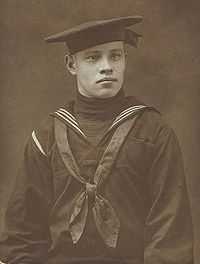USS Utowana (SP-951)
 | |
| Career (USA) | |
|---|---|
| Name: | USS Utowana |
| Builder: | Neafle and Levy, Philadelphia, Pennsylvania |
| Laid down: | 1891 |
| Acquired: | by the Navy in the summer of 1917 |
| Commissioned: | 30 October 1917 as USS Utowana (SP 951) |
| Decommissioned: | 11 September 1919 |
| Renamed: | USS Victorine (SP-951) (date not known) |
| Struck: | circa 1919 |
| Fate: | sold 13 September 1920 |
| General characteristics | |
| Type: | Trawler |
| Tonnage: | 414 gross tons |
| Length: | 168' 9" |
| Beam: | 27' 9" |
| Draft: | 15' 9" |
| Propulsion: | steam engine |
| Speed: | 12 mph |
| Complement: | 32 officers and enlisted |
| Armament: | not known |
USS Utowana (SP-951) – also known as USS Victorine (SP-951) -- was a fishing trawler acquired by the U.S. Navy during World War I. The Navy had planned to use her as a minesweeper based out of Kittery, Maine; however, Utowana spent most of her service time operating as an armed patrol craft, responsible for escorting Allied ships across the dangerous North Atlantic Ocean. She served through the war and the armistice before returning to the United States for decommissioning.
A yacht built in Philadelphia
Utowana (SP-951) -- a yacht built in 1891 at Philadelphia, Pennsylvania, by Neafle & Levy and rebuilt as a trawler at Staten Island, New York, in 1917 for the Commonwealth Fisheries Co., Boston, Massachusetts -- was acquired by the Navy during the summer of 1917 for service as a minesweeper in the 1st Naval District and placed in commission on 30 October 1917, Lt. Comdr. Reuben K. Dyer, NNV, in command.
World War I service
Though some records indicate that the ship was later renamed Victorine, they give no date for the renaming. Moreover, the trawler was consistently referred to thereafter as Utowana both in official and unofficial publications.
In any event, the trawler was assigned to Division 13, Squadron 5, Patrol Force. That organization, made up various types of ships and craft, was responsible for patrol and escort duties overseas. In addition to the European bases such as Brest in France and Queenstown in Ireland, ships of the Patrol Force operated in such diverse areas as the Caribbean and the Azores.
While no records have been found indicating where Utowana served before arriving on the French coast early in 1918, she operated briefly at Bermuda and perhaps for a short period at Ponta Delgada in the Azores.

Crossing the Atlantic
It is known that she departed Newport, Rhode Island, on 4 November 1917 in company with Hannibal, Helenita (SP-210), Margaret (SP-527), May (SP-164), Rambler (SP-211), and Wenonah (SP-165). Each yacht towed a submarine chaser. After five days at sea and in spite of a breakdown apiece for Margaret, May, Helenita and Utowana, the little task group arrived in Hamilton, Bermuda.
Apparently, Helenita and Utowana remained behind in Bermuda when the other four yachts—augmented by Cythera (SP-575), Artemis (SP-593), and Lydonia (SP-700) departed Hamilton on 18 November bound for Ponta Delgada. Presumably, Utowana -- like Helenita -- stayed in Bermuda to conduct patrols in surrounding waters, though it is also possible that she remained behind for repairs. Records giving details simply do not exist.
In any event, the former yacht reached the French coast in February 1918. Thereafter, in all probability, she provided escort services to coastal convoys and conducted antisubmarine patrols of French coastal waters.
Post-war service
About the time of the armistice, the armed trawler began to assist Favorite (SP-1385) in salvage and repair work. Following the armistice, she probably continued her salvage work.
Post-war decommissioning
Utowana returned to the United States in August 1919 and was assigned to the 3d Naval District. She was placed out of commission on 11 September 1919. Just over a year later, on 13 September 1920, she was sold to the Denton Shore Lumber Co., Tampa, Florida.
In the mid-1920s, "Utowana" was purchased by Allison V. Armour and refitted for scientific exploration (1926 - 1927) in the Canary Islands, the Balearic Islands, Southeast Asia, and West Africa. Source: The story appears in David Fairchild's book "Exploring for Plants" (1930), pp. 1 - 2, 221 (Grand Canary and Lanzarote), 234 (Balearic Islands), Ceylon (282), and West Africa (457). A photo of Utowana after refitting appears on p. 9. On p. 580 Fairchild again refers to the Utowana expedition. David Fairchild's later book "The World Grows Round My Door" (1947) says that the yacht "disappeared in the explosions of war" (307). He mentions yellowing photographs.
See also
- U.S. Navy
- World War I
References
- This article incorporates text from the public domain Dictionary of American Naval Fighting Ships. The entry can be found here.